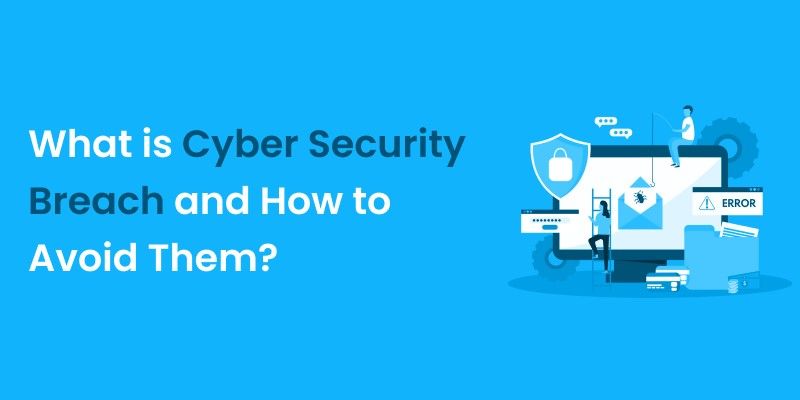
What is Cyber Security Breach and How to Avoid Them?
In today’s interconnected world, where technology has woven itself into the fabric of our daily lives, the specter of cyber security breaches looms large. These breaches occur when unauthorized individuals gain access to sensitive information, potentially causing significant harm to individuals and organizations.
A Cyber Security Course is crucial in understanding and preventing cyber security breaches. It equips individuals with the knowledge and skills to identify vulnerabilities and effectively protect against threats like weak passwords and phishing attacks. By enrolling in such a course, one gains the ability to safeguard personal information and digital assets, ensuring a resilient defense against evolving cyber threats.
In this blog post, we’ll delve into the intricacies of cyber security breaches, their underlying causes, and most importantly, equip you with the knowledge to fortify yourself and your valuable data against such attacks.
Comprehending Cyber Security Breaches:
At its core, a cyber security breach is akin to a digital break-in, where unauthorized parties gain access to computer systems, networks, or accounts, enabling them to pilfer or manipulate sensitive information. This can encompass a wide array of data, including personal information, financial details, intellectual property, and more.
Root Causes of Cyber Security Breaches:
Understanding the underlying causes of cybersecurity breaches is paramount in developing effective strategies to mitigate risks. Here are some prevalent factors contributing to such incidents:
Inadequate Password Strength: The use of simplistic or easily guessable passwords represents a significant vulnerability, as it facilitates an attacker’s ability to swiftly gain unauthorized access to accounts.
Phishing Attacks: Cybercriminals employ sophisticated tactics, often in the form of deceptive emails or messages, to trick individuals into divulging their login credentials or clicking on malicious links, thereby granting unauthorized access.
Neglected Software Updates: Failing to keep software, especially security patches, up-to-date leaves systems vulnerable to known vulnerabilities. Attackers frequently exploit these weak points to breach security measures.
Malicious Software and Viruses: Malware and viruses represent a formidable threat, as they are specifically designed to infiltrate and compromise computer systems. These malicious programs are often deployed with the aim of exfiltrating sensitive information.
Unsecured Wi-Fi Networks: Utilizing public or unsecured Wi-Fi networks poses a substantial risk, as it exposes data to potential eavesdroppers who may intercept and misuse sensitive information.
Insufficient Employee Training: A lack of awareness and understanding among employees regarding cybersecurity best practices can create opportunities for breaches. Educating staff on recognizing and responding to potential threats is crucial in fortifying an organization’s defenses.
Inadequate Access Controls: Weak or improperly configured access controls within an organization’s network infrastructure can inadvertently provide unauthorized individuals with entry to sensitive systems and data.
Insider Threats: Malicious or negligent actions by employees, contractors, or business partners can pose a significant risk. These individuals may intentionally compromise security measures or inadvertently expose sensitive information.
Inadequate Data Encryption: Failing to encrypt sensitive data during storage or transmission leaves it vulnerable to interception and unauthorized access.
Lack of Regular Security Audits: Infrequent or absent security audits can result in overlooked vulnerabilities and weaknesses in an organization’s security posture. Regular assessments are vital in identifying and rectifying potential risks.
Vendor or Third-Party Risks: Relying on external vendors or third-party services without conducting thorough security assessments can introduce vulnerabilities into an organization’s network.
Inadequate Incident Response Planning: Without a well-defined incident response plan, organizations may struggle to effectively mitigate and recover from security breaches, potentially exacerbating the impact of the incident.
Strategies to Avert Cyber Security Breaches:
Utilize Strong Passwords
Create robust passwords that comprise a blend of uppercase and lowercase letters, numbers, and special characters. Avoid using easily guessable information like birthdays or common words. Remember, a strong password forms the first line of defense against unauthorized access.
Implement Multi-Factor Authentication (MFA)
Add an extra layer of protection by requiring an additional form of authentication, such as a code sent to your phone, alongside your password. MFA significantly enhances your security posture, as it necessitates multiple steps for authentication.
Stay Vigilant Against Phishing Scams
Exercise caution with unsolicited emails or messages that request personal information or prompt you to click on links. Always verify the sender’s identity before taking any action. Cybercriminals employ various tactics, so remaining vigilant is crucial to avoiding falling prey to phishing attacks.
Keep Software Updated
Regularly update your operating system, applications, and antivirus software. This practice ensures that any known vulnerabilities are patched, reducing the risk of exploitation by cyber attackers. Staying up-to-date is a fundamental aspect of maintaining a secure digital environment.
Install a Reliable Firewall and Antivirus Software
A firewall acts as a vigilant guard for your computer, monitoring incoming and outgoing traffic. Coupled with effective antivirus software, it forms a robust defense against malware and other malicious programs. This dual protection layer is essential for identifying and removing potential threats.
Secure Your Wi-Fi Network
Strengthen your network security by changing the default login credentials for your router and using a strong, unique password. Additionally, consider hiding your network name (SSID) and implementing encryption protocols like WPA3. These measures thwart unauthorized access and ensure a secure online experience.
Frequently Back Up Your Data
In the event of a breach, having recent backups of your crucial files can be a lifesaver. Store your backups on an external hard drive or a secure cloud service. This practice ensures that even if your primary data is compromised, you can swiftly recover without significant loss.
Exercise Caution with Online Sharing
Avoid oversharing personal information on social media platforms. Cybercriminals often exploit this information for targeted attacks. Maintaining a cautious approach to online sharing is pivotal in safeguarding your privacy and security.
Educate Yourself and Your Team
Stay informed about the latest cyber threats and best practices for online security. Sharing this knowledge with your family or colleagues ensures that everyone is equipped to navigate the digital landscape safely. Continuous education is a powerful tool in fortifying your collective online defenses.
Conclusion
Cyber security breaches pose significant risks, but by adhering to these fundamental yet pivotal steps, you can significantly mitigate your vulnerability to such incidents. Remember, adopting proactive measures to safeguard your digital presence is not merely advisable, but imperative in today’s interconnected world. Stay vigilant, stay secure!






